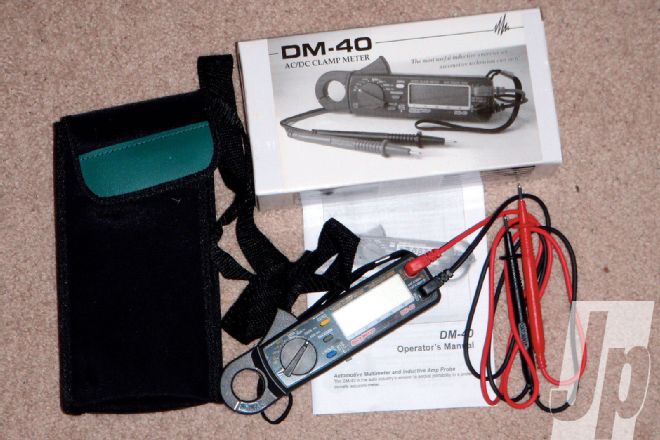
Hey guys, you know me by now. I'm Randy, and while I'm not the brightest bulb in the box, over time I've learned a lot by trying things over and over-often learning from smarter people than I (usually after I did something wrong). So I'm back to share some or the other things I've learned about how to make sure your Jeep always starts.
It seems like no matter what Trasborg does, when he's ready to take one of his Jeep piles for a drive, it has a dead battery. If you don't drive your Jeep frequently, you might have the same problem. The problem is that in a fuel-injected vehicle, there's always a draw on the battery that over time will eventually kill even the heartiest battery. I got tired of hearing him complain about it, so I went over there to see what I could do.
You see, your radio, fuel injection computer, and other such electronics requiring memory draw power even when the Jeep is turned off. If you drive your Jeep frequently, you probably won't notice this problem, but if you drive it infrequently or park it for the winter, you might return to a dead battery. If you kill any car battery dead enough, you will notice loss of performance, and it might stop taking a charge altogether.
Trasborg is running a red top Optima battery in this '94 Wrangler, as that is what was recommended when he bought the battery. However, many Jeeps later, this YJ just doesn't get out all that much anymore and he's been complaining about having to charge it every other week or it won't start. The yellow and blue top deep cycle Optima batteries deal with being killed better than the red, but kill any of them dead enough, and you could end up with dead cells and less cranking amps than you once had.
The key is either to take the Jeep for a drive every so often, remove the battery from the Jeep, or hunt down whatever it is that is sucking the power out of the battery while it sits unused. There are several ways to do that, including chasing voltage or disconnecting wires and measuring amp draw at the battery, but my number one solution is to use an inductive ammeter. Just catch the wire between the clamps and you get an immediate reading.
Sounds like magic, doesn't it? That's what I thought at first, too. I thought that the only way way to figure this stuff out was by disconnecting the wire, putting the meter in line with it, and measuring; after measuring, reconnecting the wire, and repeating for the next one. Well, it's true, it really is easy to chase down those pesky electrical parasites.
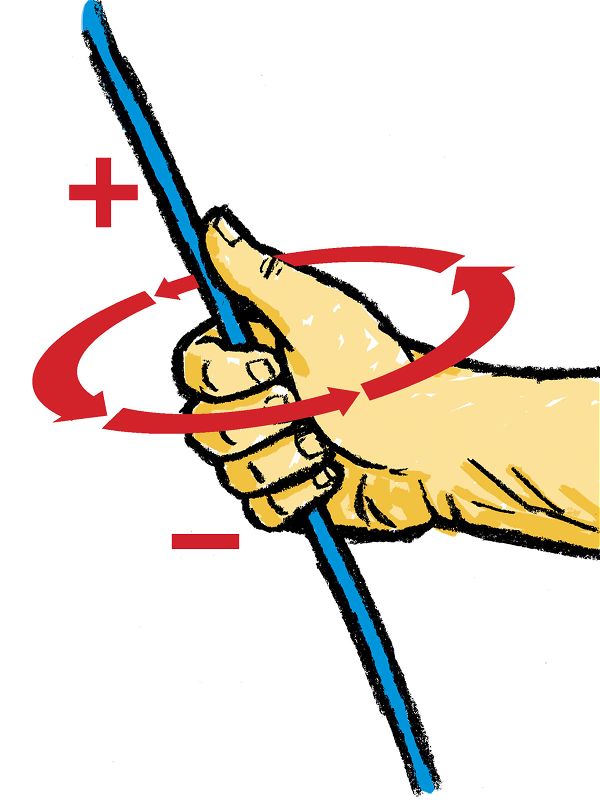 When an old electronics teacher told me about parasitic drain, I couldn't get past picturing little bugs in the wires sucking down electricity. Once I got past that, he told me about the right hand rule. As electricity flows from negative to positive, it creates a magnetic field. That field gets bigger the more electricity is flowing. The field moves out from the wire at 90 degrees to the flow of electricity, and if you point your thumb towards the positive, your four fingers will show you how the magnetic field is moving.
When an old electronics teacher told me about parasitic drain, I couldn't get past picturing little bugs in the wires sucking down electricity. Once I got past that, he told me about the right hand rule. As electricity flows from negative to positive, it creates a magnetic field. That field gets bigger the more electricity is flowing. The field moves out from the wire at 90 degrees to the flow of electricity, and if you point your thumb towards the positive, your four fingers will show you how the magnetic field is moving.
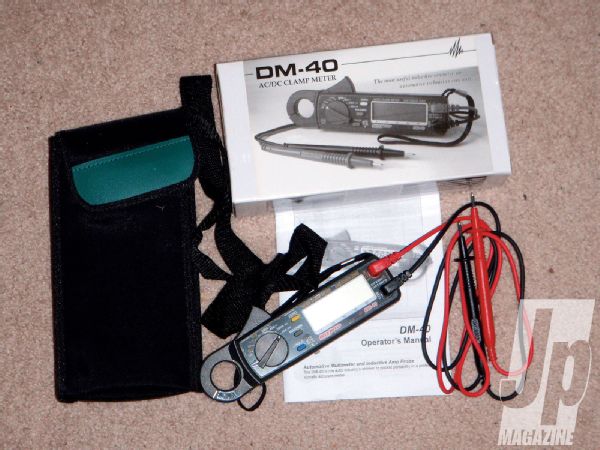 Sorry if that was kind of heavy, but I wanted you guys to get the invisible force at work here. This is an Auto Meter (that's right, the gauge people) AC/DC Clamp Meter (DM-40), and in addition to all the normal multimeter stuff, it can measure amperage by picking up that magnetic field. It is good for up to 200 amps, so you can play around with a winch, but not under much of a load (a winch can easily pull 400 amps or more under heavy load). The meter comes with test leads, an instruction manual, and a carry bag. For this story, we didn't need any of that.
Sorry if that was kind of heavy, but I wanted you guys to get the invisible force at work here. This is an Auto Meter (that's right, the gauge people) AC/DC Clamp Meter (DM-40), and in addition to all the normal multimeter stuff, it can measure amperage by picking up that magnetic field. It is good for up to 200 amps, so you can play around with a winch, but not under much of a load (a winch can easily pull 400 amps or more under heavy load). The meter comes with test leads, an instruction manual, and a carry bag. For this story, we didn't need any of that.
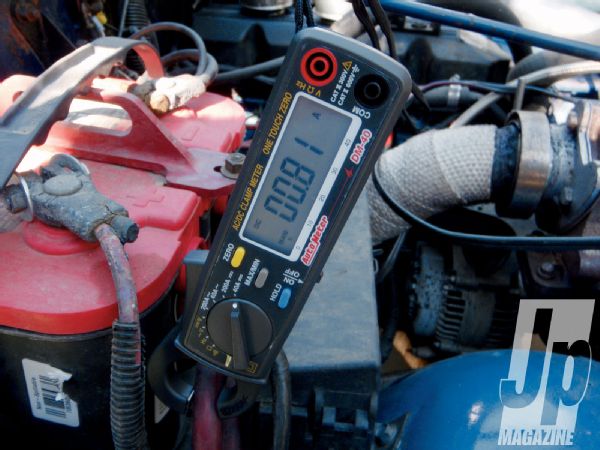 Many old-school Jeeps with carburetors have no need for power when the Jeep is off. In a modern fuel-injected vehicle, at least a 0.02 to 0.05 amp (20 to 50 milliamps) draw is common. I've seen many even drawing up to 0.40 amp (400 milliamps) with no problems. Anything above that is excessive and will cause issues. The 0.81 amp (810 milliamps) that Trasborg's Wrangler is pulling with nothing on is excessive and needs to be taken care of. Make sure that when you are measuring you keep the meter "pointing" the correct way. It is marked which way the positive terminal should be.
Many old-school Jeeps with carburetors have no need for power when the Jeep is off. In a modern fuel-injected vehicle, at least a 0.02 to 0.05 amp (20 to 50 milliamps) draw is common. I've seen many even drawing up to 0.40 amp (400 milliamps) with no problems. Anything above that is excessive and will cause issues. The 0.81 amp (810 milliamps) that Trasborg's Wrangler is pulling with nothing on is excessive and needs to be taken care of. Make sure that when you are measuring you keep the meter "pointing" the correct way. It is marked which way the positive terminal should be.
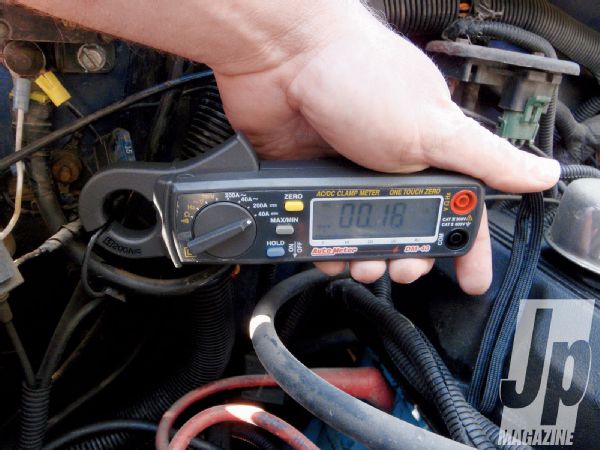 We needed to select the range on the multimeter, and we knew we'd be looking for less than 1 amp, so we selected the "40A" range, which is good for up to 2 digits to the left of the decimal place. If there was a "4A" spot, we would have selected that for more accuracy at the range we were trying to measure. Trasborg thought that the aftermarket radio was the culprit, so we tested that next. It was drawing 0.18 amp, which is on the high side, but still acceptable. After that, he was out of ideas. I always check the aftermarket stuff first, then check the factory stuff.
We needed to select the range on the multimeter, and we knew we'd be looking for less than 1 amp, so we selected the "40A" range, which is good for up to 2 digits to the left of the decimal place. If there was a "4A" spot, we would have selected that for more accuracy at the range we were trying to measure. Trasborg thought that the aftermarket radio was the culprit, so we tested that next. It was drawing 0.18 amp, which is on the high side, but still acceptable. After that, he was out of ideas. I always check the aftermarket stuff first, then check the factory stuff.